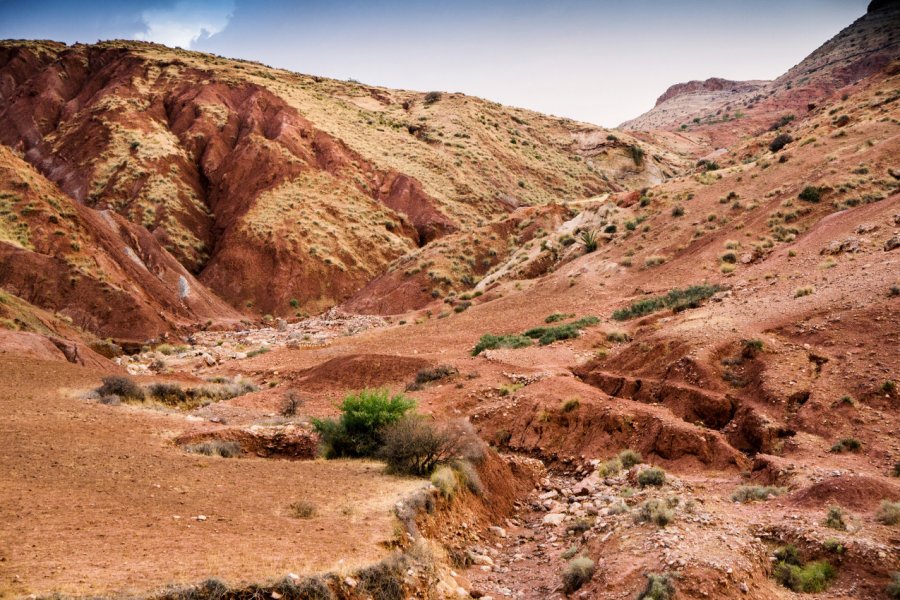Travel Guide Vallée Du Zat
Find an accommodation
Advertising
If there's one place that gives the impression of being frozen, as if out of time, it's the Zat valley, which has managed to preserve its authenticity right up to the present day by staying away from the big circuits. Here, life is simple, authentic and unspoilt. Just an hour's drive from Marrakech, you'll find yourself immersed in nature, in the countryside, overwhelmed by the wave of unexpected greenery that covers the bottom of the wadi. This is where you'll come across the farmer on his donkey returning from the weekly souk, or a group of women happily scrubbing laundry in the river while their children splash about. The scenery on the way to Tighdouine is breathtaking, as you climb the gentle slopes of the Atlas foothills. On either side of the valley, centuries-old red adobe douars stand out against the grey or pale green rock, stretching along the riverbanks. The panorama of walnut and juniper trees is omnipresent and a constant source of admiration. People come here to regenerate, in an almost absolute calm, far (but not that far) from the hustle and bustle of Marrakech, and to meet villagers not yet jaded by the mass invasion of tourists as is the case in the neighboring Ourika valley. You'll come to hike, either on foot or on a mule rented for a few coins. You can even plan a stay of several days to immerse yourself in Berber life by staying with local people, visiting different villages, a women's embroidery cooperative or the potters' village of Talatast.To reach the valley, take the road towards Ouarzazate as far as the village of Aït Ourir, which joins the Oued Zat and marks the end of the Haouz plain. If it's a Tuesday, you'll enjoy the atmosphere of the weekly Tlat n'lmi n Zat souk, which receives very few tourists. From the road, you'll have a fine view of the high, crenellated walls of the kasbah. Arriving in Aït Ourir, you have two options at the entrance to the village: to the left, head for the town center, and straight ahead, take the bypass over the Zat and into the valley. Km 36: leave the beautiful road heading straight for Ouarzazate and take the small asphalt road on the right, towards Tighdouine. It winds through plantations of olive trees and verbena, tomatoes and onions. In spring, patches of flowering oleanders add to the beauty of the area, contrasting with the greenish clumps of poplars. Km 52 : Tighdouine, the last village before you really enter the valley. A half-hour's walk takes you to the Sidi El Wafi spring, discovered in 1990, whose delicious sparkling mineral water is said to cure stomach problems. These springs (7 in all) are a popular getaway for Moroccan families, who spend the day there and lunch in the friendly little gargotes nearby. Do as they do and take empty bottles with you to fill them with this magnificent water with its healing properties. If you need it, you can buy it on site. And to complete the experience, let yourself be tempted by a highly aromatic herbal tea - no fewer than twenty-five, according to the herbalist.The region, so abundant in color, is not lacking in assets, and other trails allow you to discover a different valley, less steep but just as attractive. The village of Ouinimzen, for example, appears superb, clinging to its mountainside where time seems to have stood still. Tizirt, with its houses clinging to the slope and surrounded by walnut trees. Finally, the village of Ansa, at an altitude of 2,000 m, marks the end of a potential hiking itinerary. The most courageous will climb to the Tanofti pass at 2,300 m via a mule track. The view over the permotriassic Yaggour plateau is spectacular and rewards your efforts. These high pastures have been used for thousands of years by shepherds on their way up to the fertile lands, and are dotted withazibs (sheepfolds) that are home to an impressive number of goats in summer. It's here that you can discover rock images engraved on sandstone slabs, whose rich heritage is indisputable. Some twenty sites have been identified, featuring geometric figures, sun wheels, axes, domestic animals and oxen, not to mention armed humanoids, evidence of occupation since the late Neolithic period.It's up to us, as visitors, to do our utmost to ensure that these villages and valleys retain their soul. By respecting a few elementary rules, such as dressing decently or not photographing a person without his or her consent, you can contribute to the development of these places without harming the fragile balance of social life and Berber communities.
Suggested addresses Vallée Du Zat
Weather at the moment
Advertising
Organize your trip with our partners Vallée Du Zat
Transportation
Book your plane tickets
Car Rental
Boat rental
Accommodation & stays
Find a hotel
Holiday rental
Find your campsite
Tailor-made trip
Immersion travel
Services / On site
Activities & visits
Find a doctor




